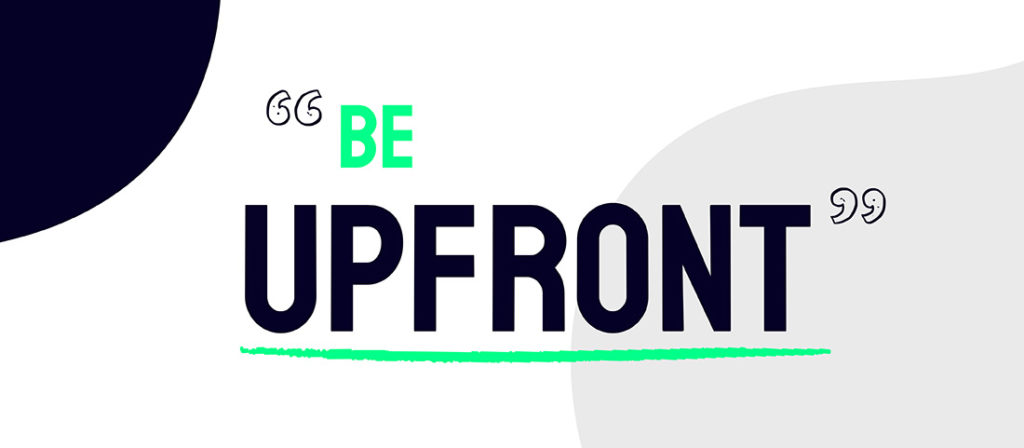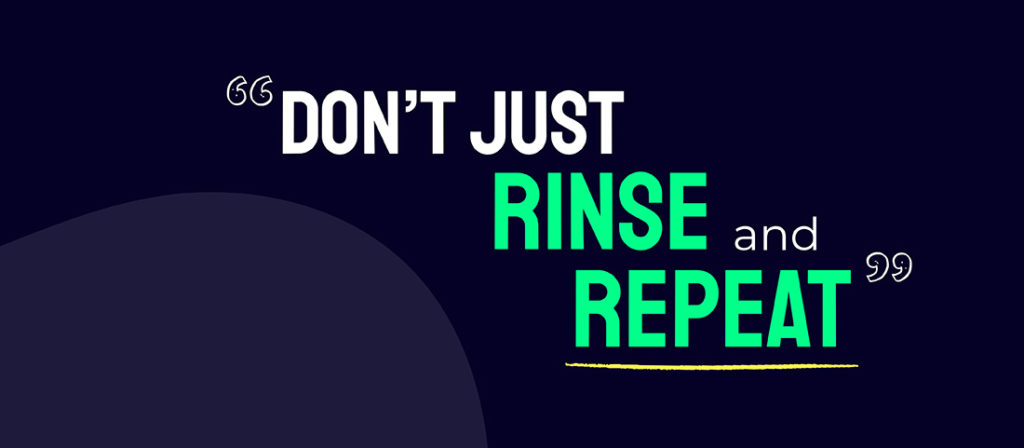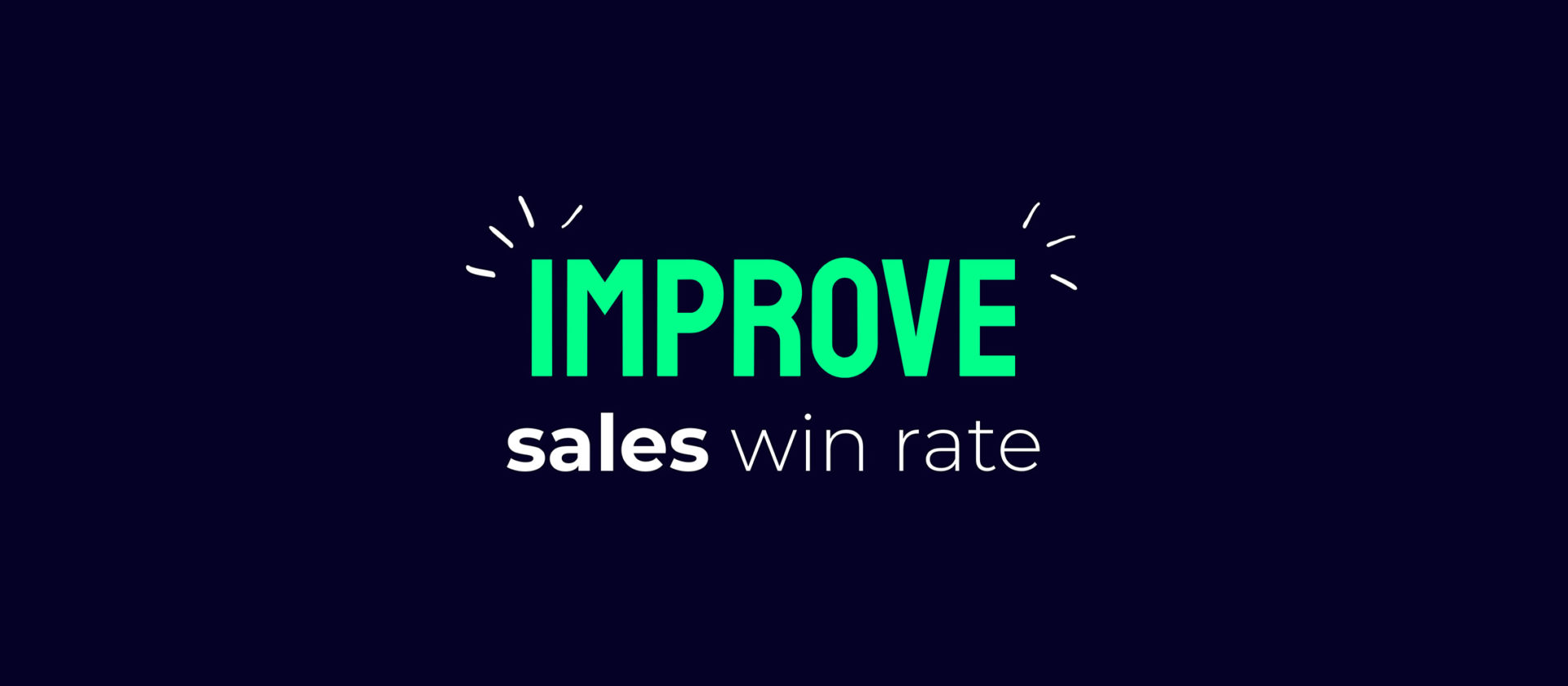Eight ways to make meaningful connections, build lasting relationships, and improve your sales win rates for good.
When I was seven years old, I decided I wanted to be able to do a backflip. You know, like a Ninja Turtle. Actually, I wanted to do a backflip off a motorbike like a Biker Mouse from Mars, but I didn’t have a motorbike and I’d previously lost a lot of skin going over the handlebars of my push bike, so I decided a Ninja Turtle would suffice.
I was determined. I spent hour after hour, launching myself from elevated surfaces onto squishy ones. Day after day, I would fail, dust myself off and try again. This went on for a whole summer. In kids’ years, that’s loads.
Did I manage to do a backflip? No. Did I get any closer on day 45 than I had on day one? No.
What’s stopping you improving your sales win rate?
We’re taught as kids that if we want something enough, and we put all our effort into it, we’ll achieve it. But that’s not the whole story. Without appropriate knowledge and guidance, without knowing why I was failing and how to improve, all I achieved was a few bumps to the head and a bruised ego.
But we grow up, we learn, and we do things better, right? Well, if you’ve been trying really hard to improve your sales win rate, and you’re not getting anywhere, maybe you’re no better than I was when I was seven.
It’s all about learning smart. We all want to win, but instead of charging forward with enthusiasm and brute force, like I did towards that elusive backflip, we need to take a step back and figure out what we’re doing wrong, and how to learn from our mistakes.
According to CSO Insights, win rates in the UK have sat at a steady average of 47% for five years, so – on the whole – we’re not learning as smart as we could be. That changes now. Here are eight ways you can break away from the average and improve your sales win rate right now.
1. Know your downfalls
It’s likely you have pre-categorised loss reasons to keep track of why prospective clients are choosing not to work with you, but are these working as hard as they could?
When was the last time you assessed those loss reasons, to check they’re still relevant, and covering as many eventualities as possible? Understanding why you’re losing opportunities is key to giving your salespeople the training they need. However, if your loss reasons are too generic, or if your salespeople are simply hitting Reason unknown every time, you’re never going to understand the problem enough to solve it.
By clearly defining your loss reasons, you can better prepare your team to be able to speak about the specific areas they’re currently tripping up over. You can pinpoint the exact type of training each individual needs.
Look at the big picture
This analysis needs to extend across your entire sales process as well. Most companies only look at the bottom of the funnel to find out where deals went wrong, but if you look from beginning to end, you can smooth out more inefficiencies.
If a team member has more losses near the start of a prospective customer relationship, they might need help with refining their qualification process, or you might want to consider providing them with tailored follow-up materials to ensure their message is being heard and remembered.
Perhaps they just haven’t found the story that works for them, that feels natural and that they can tell with passion. Your company story should be consistent, but how it’s told needs to be personal to each salesperson and flexible to the audience. Creating a presentation experience which is both consistent and easily personalised is not an easy task, but it’s vital if you want to give your sales team the tools they need to boost that win rate.
If they’re losing potential business closer to the bottom of the funnel, they may be ineffective at addressing objections, poor at negotiating, or their presentation skills might benefit from an expert hand.
Think outside the average when it comes to loss analysis, to move your sales team above the average.
2. Consider how well you really understand your audience
One of the secrets to improving sales win rate is to not leave out any decision makers or influencers. You need to make sure your message is pushing the buttons of each individual with the power to say yes or no.
When you see an opportunity, it can be tempting to plough forward, using the same recycled story because you already have it to hand. But if you take a moment to pause, to understand the people you want to connect with, what their unique challenges are, and how you can solve them, there’s no way you’re going to miss that target.
Use your initial conversation to uncover who the stakeholders would be in this decision. Most business decisions include four or more people, so find out who they are so you can work out the best way to reach them. The aim is to loop them in from the start, to avoid any last-minute roadblocks after you’ve already put all your time and energy into nurturing the prospect.
Make discovery part of your process

Make it part of your process to run a discovery session at the start of the sales cycle. Talk about the selfish motivations of each key player, what their personal goals are, and what’s stopping them getting there. What drives them? How do they measure success? What would the impact be of working with you? When researching win rates, CSO Insights found the stronger the personal relationships between salesperson and customer, the higher the win rates, so including this stage at the beginning is definitely worth the time.
Spend more time getting to know your prospects, as people, and focus less on simply moving them through the sales pipeline in a cold, automated fashion. Focusing on the opportunity, and their needs, will help you bring deals over that all-important finish line. And your team will be prepared for any obstacles that arise, because you will have already identified them, keeping the process moving forward smoothly. We start every project that enters our studio with a discovery session, and it allows us to create persuasive presentation experiences that hit both head and heart. Get in touch to find out more about our process and how we can help you better understand your audience.
But, of course, understanding them is just the first step.
3. Change mindsets
Once you know all their inner-most secrets, you need to make sure you have a story that’s personalised to each stakeholder. This sounds like a lot of work, but it doesn’t have to be. If you have a flexible presentation with an intuitive menu system, crafted company stories to hit every angle that frequently arises, and follow-up documents designed around common pain points, in a range of deliverables, it’s likely you’ll just have to pick the right one for the need. After all, when it comes down to it, we’re all driven by the same set of base desires.
Following your discovery session, you need to equip the whole project team with the information, assets and strategy they’ll need to carry the message forwards. They all need to understand the audience, to build lasting relationships and have an answer to every objection.
And they need to be so clear on the story that they can teach it to others. Involving all key stakeholders is rarely as easy as connecting with them on LinkedIn. There will usually be many gatekeepers to pass through before you make it to the big boss, but this can work to your advantage. Get to know these people’s challenges and dreams as well, and sell your story in a way that makes them want to pass it on. Use them as an extension of your marketing team by providing them with tailored physical and digital print assets that can spread your message without you even needing to be in the room.
4. Be upfront to improve your sales win rate

There’s no point telling little white lies at the start – to move prospects down the funnel – only to disappoint them later on. This is a waste of their time and yours. Improving your sales win rate isn’t about aligning on everything, feeding the prospect’s ego and telling them what they want to hear.
If you can be upfront and transparent early on, you’ll cut your sales cycle time right down, and increase the number of opportunities that turn into wins. Use your deep understanding of their world – and their weaknesses – to make your message stand out from everyone else in the market. Hit a nerve, but make sure you have the solution to soothe it again. Teach them something they may not know. Bust a myth. Cause positive friction and leave a lasting impression. You need to challenge their thinking, make them recognise where they can improve, and how you can help them progress.
Storytelling can help you to achieve all these objectives, but stories come in many forms, and how you deliver yours should change at every stage of the relationship. To achieve this initial clarity, consider sending out a personalised proposal document following your first interaction. This document should clearly lay out the details of their challenges and your solutions in all their unfiltered glory, and give your prospect all the information about your business that they’ll need to make an informed decision.
5. Create a hands-on experience
When it comes to the competitive game of sales, the person who provides the best experience usually wins. Salespeople who spend less time explaining their solutions and benefits, and more time giving prospects opportunities to experience them, will yield better results.
Your audience needs to be actively engaged in the process. A passive experience will breed apathy. Get them involved with interactive presentations and marketing materials created just for them. Include 3D product experiences, built within PowerPoint, and rethink what it means to present your products.
This experience shouldn’t be just smoke and mirrors: something showy that’s so dazzling and flashy they forget what it is you’re even pitching them. When people experience a message, they understand it better, they connect with it emotionally and they can see themselves in that story. It does a big part of the sales job for you.
See how we transformed Outright Games’ passive presentation into an interactive first-person player experience and instantly transformed the board room into a playground for the young at heart.
6. Empower your people and improve your sales win rate
It’s likely sales enablement is already a part of your strategy, but is your training designed for all types of learner? Has it been carefully considered to meet the needs of the individuals within your sales team? Has it been designed to help cement understanding and improve memory?
Sales enablement not only equips your salespeople with the right tools, but it will also help align your audience knowledge to their business stories. But only if it’s done right. Your training should help your people draw a line from any customer challenge to a solution your business can offer.
Your internal training materials should be just as easy to understand, and just as emotive, as your external presentations. Professionally-designed training documents break down complicated messaging and highlight the need-to-know information. They make sure people of all learning types have the same chance at success.
But just knowing what to say won’t crank that sales win rate up as high as it can go. Your people need to know how to deliver these messages. They need to understand the nuances of persuasive communications from every angle. They need to become master communicators. Presentation skills training can transform raw talent for talking into as close to mind control as ethics allows.
To find out more about creating messages that everyone can understand, retain and connect with, watch our webinar on forging emotional connections.
7. Don’t just rinse and repeat

According to Gleanster Research, only 25% of leads are ready to buy. And another study found that 80% of sales require an average of five interactions before the prospect agrees to a sale. But you can’t just set up an automated follow-up process in your CRM tool and expect to see your sales win rate increase.
DemandGen found that leads nurtured with tailored content produce a 20% increase in opportunities. You need to sell knowledge, not products, and tell a story relevant to the individual you’re talking to. It all boils down to showing those key stakeholders that you can make them more successful. And you can’t do that with the same generic follow-up emails.
Follow-up smarter
However, you don’t need to create marketing materials from scratch for each lead either. By creating digital documents, using software that anyone has access to, you can have a ready framework for every communication. This document should tell your company story in a compelling and persuasive way. But it should also have placeholders for personalisation. Then, your salespeople just need to add snippets of tailored narrative each time. If you create these documents in PowerPoint, you can build that core story onto a template. This means anything they add will be automatically formatted to be consistent with your brand style. Every document will look professional without too much time or energy needed from your sales team.
Gain instant trust and show unmistakable credibility by providing personalised insights to perspective clients. Doing this can boost your win rate to 55.2%, according to that same CSO Insights study.
And don’t forget to establish next steps at every interaction. As well as following up consistently, book in the next call before you finish the last. This keeps momentum going and ensures that lead doesn’t fizzle out.
8. Don’t only focus on what you don’t have
The grass is always greener, and all that.
New business isn’t the only business. One largely untapped resource for increasing win rates lies in your existing client list. These people already trust you and your product. They already see the benefits and they can be huge advocates for your value.
Don’t neglect upsell, cross-sell or referral opportunities while you’re chasing those shiny new leads. Companies that focus on referrals were found to sit at the 57.4% win rate mark. Those that were unable to generate new business from existing were way down at 43.9%. So, don’t start eyeing up that new thing as soon as you’ve sent the invoice for the last project. Make your clients feel heard, even after your transaction is over. This could see you gain new business without having to put in so much work.
Ensure your clients have nothing but the best experience from start to start again. Get them to see you as a trusted partner. Ask for feedback, and act on it. And they won’t be able to stop themselves recommending you.
Improving sales win rate takes more than time

Improving your win rate doesn’t just naturally happen as you gain more experience. You need a strategy. By implementing these eight ideas into your sales process, you can learn from your mistakes, use the tools and advocates already at your disposal, and increase not only win rate, but also speed to that win.
Don’t sell harder, sell smarter.


